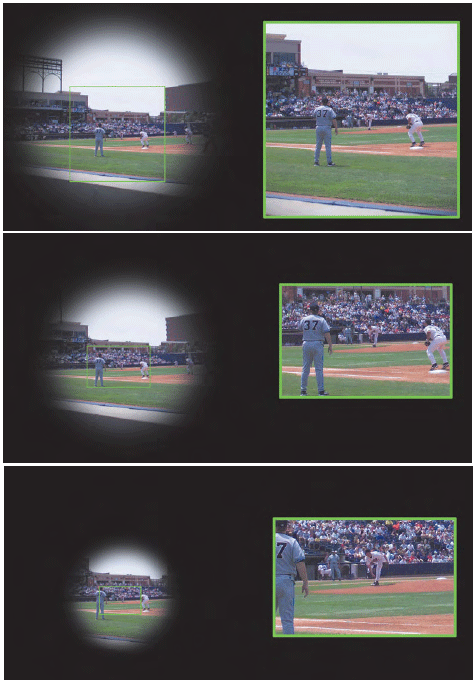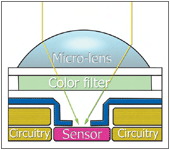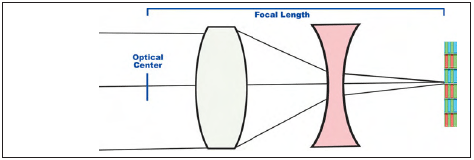Lenses and dSLRs
Most of the vendors who sell both film and digital SLRs, including Nikon, Canon, and Minolta, produce one line of optics that fit both their film-based and digital cameras. Some, such as Nikon and Olympus, have a second line of lenses that work only with digital SLRs. Olympus, in particular, with its “Four-Thirds” systems (see Digital SLR Techonolgy section), has pioneered a start-from-scratch, built-for-digital SLR product line.
Although you can use lenses designed for film SLRs on your digital SLR, there are good reasons not to. Lenses designed for digital cameras with sensors that are smaller than full-frame size can be made more compact and lighter. There are also some technical reasons why lenses designed for dSLRs can produce better results than “full-size” lenses. Of course, if you own a digital camera with a full-frame sensor, you have no choice. You must use the lenses offered by your vendor (or by third parties) for the film version. However, as you’ll soon learn, even if you do, you may not be working with lenses that are optimized for digital photography.
Digital Differences
Although lenses designed for film and digital use all operate on the same basic principles, sensors react to the light transmitted by those lenses in different ways than film does. Digital lens designs need to take those differences into account. Here are some of the key digital differences.
Some Sensors Are Smaller Than Film Frames
You already know about this. Because many sensors are smaller than the 24mm × 36mm standard film frame, lenses of a particular focal length produce what you think of as a larger image, but which is actually just a cropped version of the same image. No “magnification” takes place; you’re just using less than the full amount of optical information captured by the lens.
The most obvious result is the infamous lens multiplier factor. Because only part of the image is captured by the sensor, your cropped version appears to be 1.3, 1.5, 1.6, or even 2.0 times larger. (Nikon’s D2x has a high-speed burst mode that crops the already cropped image even further to produce a 2X lens multiplier.) While this multiplier factor can be, seemingly, a boon to those needing longer lenses, it’s a hindrance in the wide-angle realm. A decently wide 28mm full-frame lens becomes the equivalent of a 45mm normal lens when mounted on a camera with a 1.6X multiplier.
There are other ramifications. Because a smaller portion of the lens coverage area is used, the smaller sensor effectively crops out the edges and corners of the image, where aberrations and other defects traditionally hide. If you use a full-frame lens on a dSLR with a smaller sensor, you may be using the best part of the lens. This is nothing new; users of pro film cameras have a much more intimate knowledge of coverage circles. They know that, say, a 200mm telephoto lens for a 2 1/4 × 2 1/4 SLR like a Hasselblad may cover a square no larger than 3 × 3 inches, whereas a 200mm lens for a view camera may have an image circle that’s 11 to 20 inches in diameter.
Still, you’d probably be surprised to realize that an inexpensive 200mm lens developed for a 35mm film camera is a great deal sharper within its 24mm × 36mm image area than a mondoexpensive 200mm “normal” lens for a 4 × 5 view camera cropped to the same size. Because 4 × 5 film is rarely enlarged as much as a 35mm film image—or digital camera image—lenses produced for that format don’t need to be as sharp, overall. Instead they need to be built to cover larger areas.
Conversely, when creating a lens that’s designed to cover only the smaller sensor, the vendor must make the lens sharper to concentrate its resolution on the area to be covered. Olympus claims that its Four-Thirds lenses have double the resolution of similar lenses it builds for its 35mm cameras.
Of course, if the coverage area is made smaller, that can re-introduce distortion problems at the periphery of the coverage circle. This is particularly true of ultrawide-angle lenses, which are difficult to produce in short focal lengths anyway, including the 12mm–24mm zoom I favor.
Three figures below illustrate the coverage circle and cropping concepts more visually. Imagine three different 50mm lenses, each designed for a different kind of SLR camera. The magnification of each lens would be identical, but the coverage area would be different in each case.

For example, the first figure represents a 50mm lens used as a wide-angle optic on a 6 × 6 cm single lens reflex. The coverage area is just a little larger than necessary to cover the full frame. If it were any smaller, you can see that vignetting in the corners would result. At the right side of the illustration is the image that the camera crops out of the lens’s coverage area to produce a slightly wide-angle view.
The second figure might be a full-frame SLR, with a slightly smaller coverage area to produce a “normal” view from the 50mm lens. The third figure would correspond to a 50mm lens designed for a smaller sensor, and would have a commensurately smaller coverage area. The 1.5X crop factor, compared to the full-frame image in the second figure, results in a short telephoto effect, roughly the same as if a 75mm lens were used on the full-frame camera.
Extreme Angles
Film’s “sensors” consist of tiny light-sensitive grains embedded in several different layers. These grains respond about the same whether the light strikes them head on or from a slight or extreme angle. The angle makes a difference, but not enough to degrade the image.
As you learned in in Digital SLR Technology section, sensors consist of little pixel-catching wells in a single layer. Light that approaches the wells from too steep an angle can strike the side of the well, missing the photosensitive portion, or stray over to adjacent photosites. This is potentially not good, and can produce light fall-off in areas of the image where the incoming angles are steepest, as well as moiré patterns with wide-angle lenses.
Fortunately, the camera vendors have taken steps to minimize these problems. The phenomenon is more acute with lenses with shorter back-focal distances, such as wide-angles. Because the rear element of the lens is so close to the sensor, the light must necessarily converge as a much sharper angle. Lens designs that increase the back-focal distance (more on this later) alleviate the problem. With normal and telephoto lenses that have a much deeper back-focal distance anyway, the problem is further reduced.
Another solution is to add a microlens atop each photosite to straighten out the optical path, reducing these severe angles. Next figure (which originally appeared in Digital SLR Technology section) shows how such a microlens operates. Newer cameras employ such a system, so you can use lenses designed for either film or digital use without worry.

Olympus’s clever Four-Thirds design is perhaps the best approach. Although the overall concept was developed in conjunction with Fuji and Kodak, Olympus is the first vendor to bring the Four-Thirds approach to a digital SLR. The company’s dSLRs and their lenses were designed from scratch for use with digital sensors that measure 22.5mm diagonally. So, the camera was designed with a longer back-focal distance to mate with lenses that had a matching back-focal distance. Even the Olympus wide-angle optics focus the light at an angle that is more friendly to the digital sensor’s needs.
Reflections
If you’ve ever looked at film, you noticed that the emulsion side—the side that is exposed to light—has a relatively matte surface, due to the nature of the top antiabrasion coating and the underlying dyes. Take a glance at your sensor, and you’ll see a much shinier surface. It’s entirely possible for light to reflect off the sensor, strike the back of the lens, and end up bouncing back to the sensor to produce ghost images, flare, or other distortions. While lens coatings can control this bounce-back to a certain extent, digital camera lenses are more prone to the effect than lenses used on film cameras.
Lens Designs
You can understand why designing lenses for digital SLRs can become extremely complex if you know a little about how lenses are created. Although typical dSLR lenses contain many elements in several groups, I’m going to explain some basic principles using just a minimal number of pieces of glass.
Next figure shows a simple lens with one positive element. This is known as a symmetrical lens design because both halves of the lens system are mirror images. The optical center of this lens is in the center of the single element, and the distance from the center to the focal plane (in this case, the sensor) is the same as the focal length of the lens. Assuming it’s a 75mm lens, that distance, the back-focus distance, would be 75mm, or about 3 inches. All you’d need to do to use this configuration would be to design a lens that positioned the single lens element at 75mm to bring the lens into sharp focus. 
Things get more complicated when you start designing a longer lens. With a 500mm optic, you’d need to design the lens so the optical center was 20 inches from the sensor. That would be quite a long lens! Indeed, so called mirror lenses exist that use a series of reflecting surfaces to fold this long optical path to produce a lens that is much shorter for its particular focal length.
But there’s another way, through the use of an asymmetrical lens design. Place a negative lens element behind the positive element, spreading the incoming light farther apart again, causing the photons to converge farther from the optical center than they would otherwise, as you can see in the figure below. The negative element has the effect of lengthening the effective focal length and moving the optical center in front of the front element of the lens. The result: a “shorter” telephoto lens. 
With wide-angle lenses, we have the reverse problem. The photons focus too close to the rear of the lens, creating a back-focus distance that’s so short that it doesn’t allow room for the mirror. Without the mirror to worry about, it wouldn’t matter if some of the elements of a wideangle lens extended far into the camera body, very close to the focal plane itself. Indeed, that’s the arrangement found in rangefinder cameras (which have no mirror) and with some lenses from the dark ages (like my 7.5mm fish-eye), which was viable on an SLR only if the mirror was locked up out of the way.
The solution here is to create an inverted telephoto lens, usually called retro-focus, which inserts the negative lens element ahead of the positive element, spreading the beam of light so that when the positive lens element focuses it again on the sensor, the focal point is much farther back than it would be otherwise. The optical center has been moved behind the center of the lens, as you can see in the next figure.

You can see that an inverted telephoto design helps digital camera lens designers produce wideangles that are physically “longer” than their focal lengths, just as the traditional telephoto configuration produced lenses that were physically “shorter” than their focal lengths. Unfortunately, these more complex lens designs lead to undesired effects in both telephoto and wide-angle lenses. A primary symptom is chromatic aberration, or the inability of a lens to focus all the colors of light at the same point, producing a color fringing effect. This color effect is caused by the glass’s tendency to refract different colors of light in different ways, much like a prism. There are actually two types of chromatic aberration: axial (in which the colors don’t focus in the same plane) and transverse, in which the colors are shifted to one side. The partial cure is the use of low diffraction index glass (given an ED code by Nikon, and UD by Canon), which minimizes the effect.
Other ailments include barrel distortion, which is a tendency for straight lines to bow outwards, and various spherical aberrations. Lens designers have countered with aspherical lens elements. As you might guess, aspherical optics are lenses with a surface that is not a cross-section of a sphere. These lenses are precisely ground (or, more recently in some consumer cameras, molded) to the required shape, and do a good job of correcting certain kinds of distortion.
Note that none of the lens designs I’ve cited are exclusive to digital SLR cameras. Such lenses can be developed for any sort of camera, but some of their characteristics come in particularly handy in the dSLR realm.
If It Ain’t Bokeh, Don’t Fix It
Lens Lust isn’t the only malady that can befall a new dSLR owner. Another illness is the search for the perfect bokeh. The term has almost become a buzzword, and is used to describe the aesthetic qualities of the out-of-focus parts of an image, with some lenses producing “good” bokeh and others offering “bad” bokeh. Boke is a Japanese word for “blur,” and the h was added to keep English speakers from rhyming it with broke.
You’ve probably noticed that out-of-focus points of light become disks, which are called circles of confusion. These fuzzy discs are produced when a point of light is outside the range of an image’s depth-of-field. Most often, circles of confusion appear in close-up images, particularly those with bright backgrounds, as shown in the figures below (the upper left). The circle of confusion is not a fixed size, nor is it necessarily always a perfect circle. The viewing distance and amount of enlargement of the image determine whether we see a particular spot on the image as a point or as a disc. The shape of the lens’s diaphragm can determine whether the circle is round, nonagonal, or some other configuration. 
Good bokeh and bad bokeh derives from the fact that some of these circles are more distracting than others. Some lenses produce a uniformly illuminated disc. Others, most notably mirror or catadioptic lenses, produce a disk that has a bright edge and a dark center, producing a “doughnut” effect, which is the worst from a bokeh standpoint. Lenses that generate a bright center that fades to a darker edge are favored because their bokeh allows the circle of confusion to blend more smoothly with the surroundings.
Evenly illuminated disks, or, worst of all, those with lighter edges (like those of a mirror lens) are undesirable. If you look carefully at upper right's figure, you can detect some bokeh of the most objectionable sort. The bokeh characteristics of a lens are most important when you are using selective focus (say, when shooting a portrait) to deemphasize the background, or when shallow depth-of-field is a given because you’re working with a macro lens, long telephoto, or with a wide-open aperture. The lower figure shows what the three general varieties of bokeh look like when captured and isolated from their native habitats so you can see them more clearly. |

